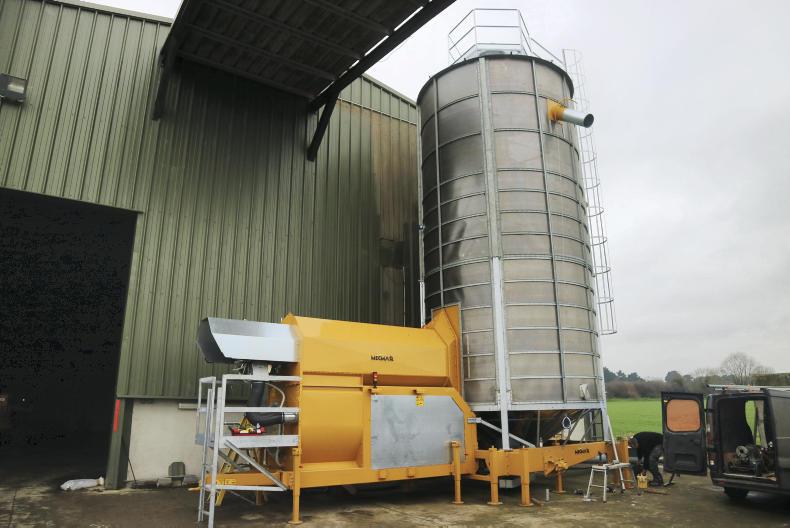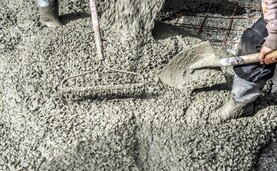The decision to install a batch grain drier or a continuous flow grain drier is down to personal preference and farm system, according to Liam Brennan from Irish Grain Systems.
“Having a drier means that the farmer can dry their grain and sell it at a time that suits them. They are not at the mercy of the grain merchant as much.”
The most common type of grain driers in Ireland have the capacity for 28 to 32t, according to Liam.
“A 28t portable batch grain drier would generally cost in the region of €70,000 plus VAT and this would be a more popular option among farmers.”
“The one thing that this farmer liked is that the mobile option allows it to be moved, or sold down the line if needs be,” Liam said.
Large capacity
The drier chosen here is a 55t Mecmar mobile batch drier, the largest mobile drier currently in operation in Ireland, according to Liam.
The drier is gas powered and takes the place of a 27t drier that had worn out and needed replacement. The length of time that it takes to dry a batch of grain will depend on the moisture content of the grain entering the drier.
“The same drier is in operation in Scotland and it took in grain at 30% moisture and dried it out to 15% and it got through about 300t/day so it gives you an example of the capacity of the machine. So if the grain is coming in drier it gives you the possibility of working through a lot of grain every day,” according to Liam.

The drier is fitted with an intake auger upon which a funnel will be fitted around for ease of filling.The drier is fitted with an intake auger upon which a funnel will be fitted around for ease of filling.
The drier is fitted with an intake auger around which a funnel will be fitted for ease of filling. Grain will be drawn in and up a centre column of the drier by another auger.
The grain then falls down through the dryer with hot air blowing out of the centre column. The grain will then be taken back by the auger at the base of the drier once again, with continuous circulation occurring to dry the grain to the desired level.
There are two discharge outlets from the drier. The system can be set to automatically empty when the grain temperature reaches the designated temperatures through the outlet into the adjoining shed. The drier is fitted with two temperature sensors due to its size. Another option is to manually choose to empty the drier through an outlet to the front of the drier which could be used to direct grain into a trailer for example.

A fan is in place at the top of the drier which will extract any chaff or dust from the grain.A fan is in place at the top of the drier which will extract any chaff or dust from the grain.
A fan is in place at the top of the drier which will extract any chaff or dust from the grain which leaves you with a really clean product, according to Liam.
“The way the weather has gone, machines have got bigger and the window to complete work has got smaller so a drier was needed to be able to cope with the big demand. The last thing you want is grain sitting for hours waiting to go into the drier, you get rain then and it takes even longer to dry out, which is expensive and time-consuming,” according to James Connor, who also works with Irish Grain Systems.
The total cost of the drier is approximately €135,000 excluding VAT. The drier is applicable for Tillage Capital Investment Scheme grant aid.

The total cost of the drier is approximately €135,000 excluding VAT.The total cost of the drier is approximately €135,000 excluding VAT.
In theory, if two farmers were in partnership, a young trained farmer and a general applicant, they would be able to get a 60% grant aid on the first €80,000 of the project and 40% on the remaining €80,000. For a project like this it would mean that total grant aid would be approximately €70,000, leaving the net cost at €65,000.
Meet the specs
For any investment to be eligible for grant aid under TAMS, it must meet the Department of Agriculture’s specifications. Batch grain driers must have integral intake and discharge augers. Grain driers must be fitted with a grain cleaning and dust catchment system.
The driers may be either direct-fired, where the flue gasses pass through the grain, or indirect-fired. Indirect-fired grain driers must be fitted with a heat exchanger, and the flue gasses expelled away from the grain drying area.
The reference cost for a batch grain drier is based on the capacity in metres cubed that the drier can dry in one batch. The cost for a direct heat only is €1,203.8/m3 plus €36,284.
For indirect heat only, the reference cost is €1,316.5/m3 plus €43,481. The figure that will be used for grant aid calculation is based on the lowest of either the Department’s reference cost or the actual cost to complete the project, both excluding VAT.
The decision to install a batch grain drier or a continuous flow grain drier is down to personal preference and farm system, according to Liam Brennan from Irish Grain Systems.
“Having a drier means that the farmer can dry their grain and sell it at a time that suits them. They are not at the mercy of the grain merchant as much.”
The most common type of grain driers in Ireland have the capacity for 28 to 32t, according to Liam.
“A 28t portable batch grain drier would generally cost in the region of €70,000 plus VAT and this would be a more popular option among farmers.”
“The one thing that this farmer liked is that the mobile option allows it to be moved, or sold down the line if needs be,” Liam said.
Large capacity
The drier chosen here is a 55t Mecmar mobile batch drier, the largest mobile drier currently in operation in Ireland, according to Liam.
The drier is gas powered and takes the place of a 27t drier that had worn out and needed replacement. The length of time that it takes to dry a batch of grain will depend on the moisture content of the grain entering the drier.
“The same drier is in operation in Scotland and it took in grain at 30% moisture and dried it out to 15% and it got through about 300t/day so it gives you an example of the capacity of the machine. So if the grain is coming in drier it gives you the possibility of working through a lot of grain every day,” according to Liam.

The drier is fitted with an intake auger upon which a funnel will be fitted around for ease of filling.The drier is fitted with an intake auger upon which a funnel will be fitted around for ease of filling.
The drier is fitted with an intake auger around which a funnel will be fitted for ease of filling. Grain will be drawn in and up a centre column of the drier by another auger.
The grain then falls down through the dryer with hot air blowing out of the centre column. The grain will then be taken back by the auger at the base of the drier once again, with continuous circulation occurring to dry the grain to the desired level.
There are two discharge outlets from the drier. The system can be set to automatically empty when the grain temperature reaches the designated temperatures through the outlet into the adjoining shed. The drier is fitted with two temperature sensors due to its size. Another option is to manually choose to empty the drier through an outlet to the front of the drier which could be used to direct grain into a trailer for example.

A fan is in place at the top of the drier which will extract any chaff or dust from the grain.A fan is in place at the top of the drier which will extract any chaff or dust from the grain.
A fan is in place at the top of the drier which will extract any chaff or dust from the grain which leaves you with a really clean product, according to Liam.
“The way the weather has gone, machines have got bigger and the window to complete work has got smaller so a drier was needed to be able to cope with the big demand. The last thing you want is grain sitting for hours waiting to go into the drier, you get rain then and it takes even longer to dry out, which is expensive and time-consuming,” according to James Connor, who also works with Irish Grain Systems.
The total cost of the drier is approximately €135,000 excluding VAT. The drier is applicable for Tillage Capital Investment Scheme grant aid.

The total cost of the drier is approximately €135,000 excluding VAT.The total cost of the drier is approximately €135,000 excluding VAT.
In theory, if two farmers were in partnership, a young trained farmer and a general applicant, they would be able to get a 60% grant aid on the first €80,000 of the project and 40% on the remaining €80,000. For a project like this it would mean that total grant aid would be approximately €70,000, leaving the net cost at €65,000.
Meet the specs
For any investment to be eligible for grant aid under TAMS, it must meet the Department of Agriculture’s specifications. Batch grain driers must have integral intake and discharge augers. Grain driers must be fitted with a grain cleaning and dust catchment system.
The driers may be either direct-fired, where the flue gasses pass through the grain, or indirect-fired. Indirect-fired grain driers must be fitted with a heat exchanger, and the flue gasses expelled away from the grain drying area.
The reference cost for a batch grain drier is based on the capacity in metres cubed that the drier can dry in one batch. The cost for a direct heat only is €1,203.8/m3 plus €36,284.
For indirect heat only, the reference cost is €1,316.5/m3 plus €43,481. The figure that will be used for grant aid calculation is based on the lowest of either the Department’s reference cost or the actual cost to complete the project, both excluding VAT.









 This is a subscriber-only article
This is a subscriber-only article













SHARING OPTIONS: